Why do pepper leaves turn yellow
The main task of gardeners is to obtain a rich harvest of cultivated crops, and at the same time, not everyone pays attention to the state of foliage until the change in its color becomes too noticeable. Very often, problems with yellowing and damage to the bush arise when growing various types of pepper. With what it is connected and how to prevent this phenomenon - we will consider further.
Main reasons
If yellow spots suddenly began to appear on pepper leaves, it is necessary to find out as soon as possible what influenced the beginning of this process in order to take timely measures. As a rule, the list of such reasons is standard.
Wrong watering
The most common mistake, leading to the fact that the pepper growing on the beds in the open ground, leaves turn yellow - this is a violation of the irrigation regime.

The vegetable is sensitive to moisture, its root system is very delicate and responds to both overflow and underfill:
- With excess water, the soil does not have time to dry out, and the roots rot. At the initial stage, it manifests itself in the fact that yellow veins appear on the leaves, which then completely change color and fall off. At the final stage, the root rots completely and the bush dies.
- Insufficient watering provokes a lack of nutrients, which also leads to a deterioration in the condition of the crown, and then the fruits of pepper.
The watering scheme of pepper bushes should be changed depending on weather conditions and precipitation: in cool weather and during rains, the amount of water should be moderate, and in heat - plentiful.
To avoid yellowing of leaves, you should always monitor the condition of bushes and foliage on it and once a week 2 days after the next watering, loosen the soil to a depth of 5-6 cm.
Cold
Bell pepper is a heat-loving crop, so a sharp drop in temperature below 15 ° C at night can be a very common reason for yellowing leaves. Important! Pepper does not like cold - it weakens the immunity of the plant, so you need to water it with warm water heated in the sun. To prevent overcooling of the root system, it is necessary to mulch the soil around the stems with hay or foliage, and with strong night cooling - protect the bushes with the help of special materials (spanbond, lutrasil).

Heat
Arid summers and direct sunlight are no less destructive for leaves than cold. If the thermometer column is kept at a mark above + 35 ° C, then the wilting and yellowing of the crown can hardly be avoided.
During this period, it is necessary to provide the plants with shade whenever possible, equipping the canopy, and carry out abundant watering.
Important! In extreme heat, it is recommended to water all types of pepper either in the early morning or in the evening after 17:00, avoiding direct sunlight.
Incorrect transplant
It happens that soon after planting seedlings in open ground, the foliage of young bushes begins to become covered with yellow spots. The reason is simple: violation of transplant rules. The plant gets into new soil and immature seedlings immunity gives a malfunction.
You can avoid such a nuisance by applying the transshipment method when planting seedlings. In this case, the bushes are transferred to the holes together with a lump of earth in which they grew.

Lack of light
Sweet pepper is a light-loving crop, and bright lighting is necessary for normal growth. It happens that yellowing makes itself felt even at the stage of growing seedlings - even then, when there is a lack of light in young bushes, the leaves begin to fade, photosynthesis is disrupted.
To combat the problem, plants must be provided with daylight hours of at least 10 hours. For seedlings, it is recommended to use artificial lighting, and seedlings intended for open ground should be planted in a well-lit part of the site.
We advise you to read why spots appear on the leaves and fruits of pepper.
Nutrient deficiency
It's no secret that plants need nutrients for normal growth. If the culture grows in insufficiently fertile soil, problems cannot be avoided.
Pepper foliage is an indicator of a lack of minerals:
- with a lack of nitrogen and potassium, the leaves in the lower part of the bush suffer - first turn yellow, then dry along the edges and fall off;
- with a lack of iron, yellowing begins with the upper leaves, while the veins remain green.
In both cases, it is necessary to carry out foliar top dressing as an emergency measure to save the bushes. To do this, plant the appropriate fertilizer, according to the instructions, and with the help of a watering can irrigate the soil and the foliage itself. In the future, top dressing is done regularly, according to the rules of agricultural techniques for growing pepper (at least 1 time per month during the growing season).
Video: Yellow pepper leaves turn yellow
To eliminate nitrogen deficiency, ammonium nitrate is used for both foliar and root fertilizers. To replenish potassium reserves, potassium nitrate is used (it contains a high content of this mineral). A fertilizer solution is prepared from 20-30 g of saltpeter per 10 l of water.
Crop rotation failure
When growing pepper, regardless of whether it is bitter or sweet, it is important to follow agricultural practices. Deviation from crop rotation rules is fraught with impaired growth of bushes and a decrease in yield, leaves can also crumble in a plant.
- When growing pepper, you can not:
- to plant seedlings for several years in a row at the same place (the soil is depleted, becomes less fertile);
- plant pepper in the area where solanaceous crops were grown in the previous season (they release toxic substances into the soil);
- to shift the sowing dates (changing the duration of daylight hours or freezing negatively affects the growth of seedlings).
Root weave
Very often, when growing crops in a greenhouse, gardeners, trying to save space, thicken the planting of bushes, which, in turn, can cause foliage to drop. The roots of closely planted plants intertwine as they grow and begin to fight for nutrients in one area of the soil, which inevitably leads to depletion of the bushes. In addition, peppers that grow too thick will obscure each other, resulting in lower leaves suffering from a lack of light and turning yellow-green.
The problem can be solved only if the optimal distance between the bushes (30 cm) and regular thinning of the beds is observed. Did you know? The name of the sharpest chili pepper from the Aztec language is translated as "red".
Disease
Another and very serious reason for the color change of foliage in this vegetable crop is the defeat of its diseases:
- Fusariosis is a dangerous fungal disease that affects the entire foliage of a bush. Crohn begins to fade, turn yellow, after which it completely falls off. The risk of infection of nearby plants is very high. Infection occurs mainly through the soil (especially if cereal crops grew on the site before), and sometimes through the use of low-quality, infected seeds.
To combat the disease, it is necessary to destroy already diseased plants (burn) as quickly as possible, and to spray healthy bushes with a chemical antifungal drug of industrial production (for example, Fundazol) according to the instructions. Seeds of dubious origin are treated before sowing.
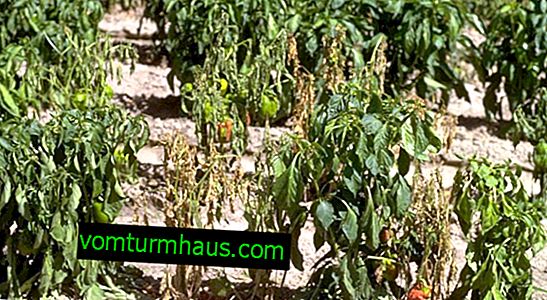
- Late blight . This disease occurs with a violation of the irrigation system or with a sharp cold snap. The crown also affects fruits that have already appeared, which are covered with brown spots and rot. At the first signs of illness, plants must be sprayed with the chemical composition for the treatment of late blight (for example, “Fitosporin”), normalize watering and provide shelter for the period of night cooling.
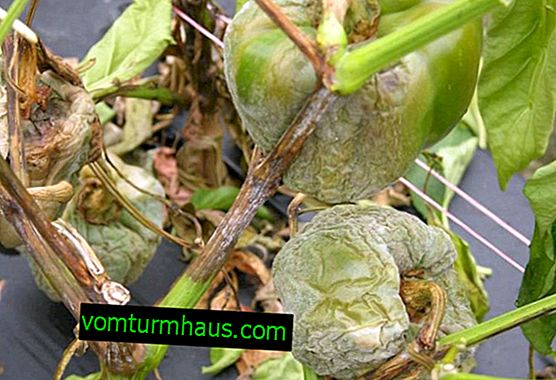
- Leaf blotch (cladosporiosis) - a disease of a fungal nature characteristic of all types of peppers. It appears on the appearance of white-yellow spots on the foliage. Having hit one bush, it can go to the rest. It is treated by treating the plant crown with a fungicide (for example, Bordeaux liquid) according to the instructions.

- Mosaicism is the most dangerous disease, the treatment and prevention of which is almost impossible. The disease is of a viral nature, enters the soil and the plant itself through gardening equipment, sometimes aphids carry it. Affected plants are subject to destruction, and the seeds are disinfected in a potassium permanganate solution for 15 minutes before sowing.
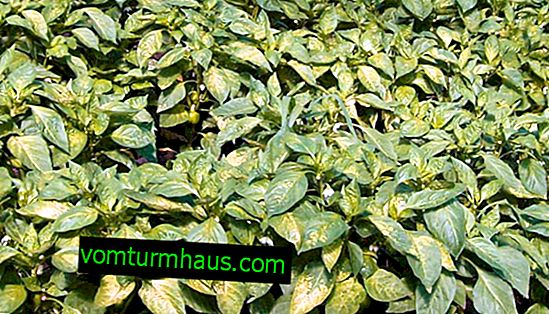
Pest attack
The foliage of a vegetable crop can suffer not only from ailments, but also from the attack of various pests:
- Bulgarian pepper most often attacks aphids . This parasite eats juice from the foliage and stems of the plant, as a result of which the foliage turns yellow and falls off. You need to fight aphid immediately: first, thoroughly rinse the foliage with a soap solution (100 g of soap per 10 liters of water), and then spray with any available insecticide (for example, “Karbofos”) according to the instructions.
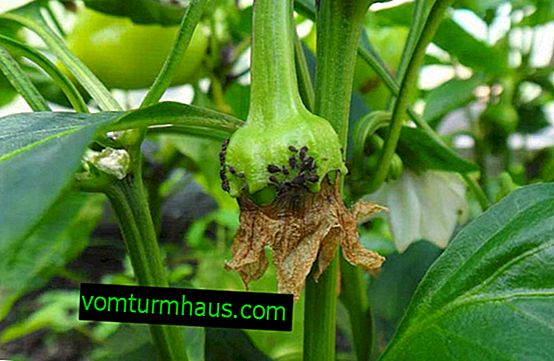
- An unpleasant parasite that is very harmful to the plant is a spider mite . It is invisible, because it is located on the lower surface of the leaves and sucks out the juice from them. The control method is similar to that used to kill aphids: mechanical removal with soapy water, insecticide treatment.

- Slugs are one of the unpleasant parasites for pepper, they eat not only foliage, but also the fruits themselves, resulting in rotting and death of part of the crop. To destroy slugs, special highly effective agents are used (for example, such as Extraflor or Arrow).

- The bear is the most unpleasant of the pests, because it is difficult to detect, and in one day it can damage the roots of about a dozen bushes. To combat the bear, regular loosening of the soil is used, the discovered holes are poured with a soap solution (100 g per 5 liters of water), and according to the instructions, the most popular drug that poison this parasite is “Thunder”.
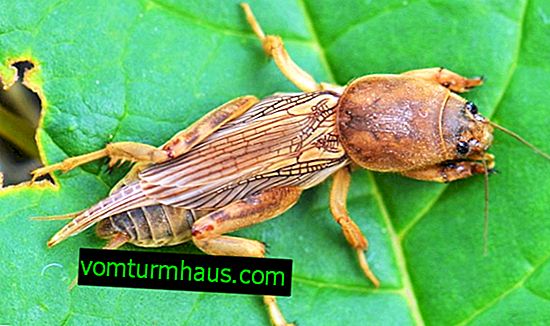
- Thrips, insects resembling microscopic grasshoppers in appearance, eat the foliage of almost all vegetable crops. It is difficult to detect them, they are very small and inconspicuous, however, they cause significant damage to the plant, since they are also carriers of infections and viruses dangerous to vegetables. Destruction is carried out according to the method of combating aphids: this is washing off larvae and adults with water jets followed by spraying with an insecticide (for example, “Fitoverm”).
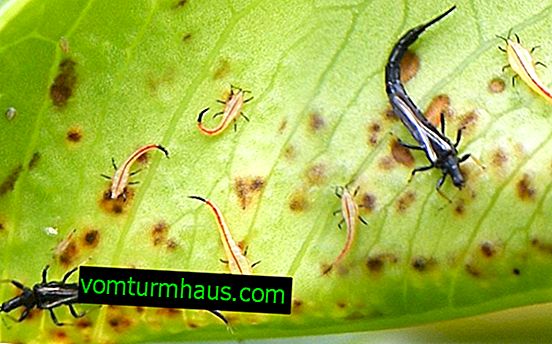
Preventive measures
Avoiding future yellowing of foliage in peppers is much easier than treating an already existing disease.
To do this, it is enough to follow the basic preventive measures:
- use only proven seeds for breeding seedlings, soak them in potassium permanganate before sowing for disinfection purposes;
- grow seedlings in separate pots to avoid the possible spread of diseases, and also to prevent root splicing;
- use caution when transplanting plants into open ground, transship the bush from the pot with an earthen lump;
- carefully choose a site for planting: it should have fertile soil and be in a well-lit place;
- observe the planting pattern: 30 cm between the bushes, 70 cm between the beds;
- provide adequate and regular watering, adjust it depending on external conditions (rain, drought);
- loosen and mulch the soil in order to preserve and redistribute nutrients and protect against parasites;
- regularly feed peppers throughout the season;
- to cover plants with a sharp decrease in air temperature;
- remove weeds from the beds;
- periodically conduct a thorough inspection of the stems and foliage.
Did you know? Cayenne peppers are added to some canary breeds to add a bright red color to their feathers.
These tips are relevant not only for bell pepper - they can be used as a prophylaxis in acute and decorative varieties.
A detailed consideration of the problem of yellowing of foliage on pepper bushes allows us to conclude that there are many reasons for this phenomenon, from violation of the rules of care and ending with the defeat of dangerous diseases. Timely preventive measures will avoid these difficulties.












